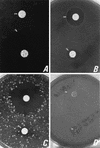Molecular identification of Gemella species from three patients with endocarditis
- PMID: 9542900
- PMCID: PMC104652
- DOI: 10.1128/JCM.36.4.866-871.1998
Molecular identification of Gemella species from three patients with endocarditis
Abstract
Gemella morbillorum and Gemella haemolysans are opportunistic pathogens which cause endocarditis and other severe infections. We report on three patients with endocarditis, one with endocarditis caused by G. haemolysans and two with endocarditis caused by G. morbillorum. The paucity of reports concerning these bacteria is probably related to the difficulties associated with their identification. For example, one of the strains reported in this study was originally sent to our laboratory with a preliminary characterization as a short "gram-negative" coccobacillus, highlighting the specific problem associated with Gram staining of these bacteria. The usefulness of 16S rRNA gene amplification, partial sequencing, and comparison of the nucleotide sequence to those in databases when standard phenotypic identification schemes are not helpful is emphasized. We also suggest that the use of simple tests, such as testing susceptibility to vancomycin for gram-negative bacteria and colistin for gram-positive bacteria, could prevent misinterpretation of Gram staining in gram-variable bacteria such as Gemella spp.
Figures


References
-
- Abboud R, Friart A. Deux cas d’endocardite tricuspidienne isolée après intervention colique. Acta Clin Belg. 1995;50:242–245. - PubMed
-
- Acar J F, Goldstein F W. Disk susceptibility test. In: Lorian V, editor. Antibiotics in laboratory medecine. 4th ed. Baltimore, Md: The Williams & Wilkins Co.; 1996. pp. 1–51.
-
- Aspevall O, Hillebrandt E, Linderoth B, Rylander M. Meningitis due to Gemella haemolysans after neurosurgical treatment of trigeminal neuralgia. Scand J Infect Dis. 1991;23:503–505. - PubMed
-
- Baron E J, Weissfeld A S, Fuselier P A, Brenner D J. Classification and identification of bacteria. In: Murray P R, Baron E J, Pfaller M A, Tenover F C, Yolken R H, editors. Manual of clinical microbiology. 6th ed. Washington, D.C: American Society for Microbiology; 1995. pp. 249–264.
Publication types
MeSH terms
Substances
LinkOut - more resources
Full Text Sources
Molecular Biology Databases
Miscellaneous

